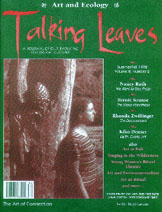As an artist and naturalist, I have long been intrigued by the ways in which night time hunters from non-industrial societies determine types, numbers, and condition of game and other creatures hundreds of meters distant through dark undergrowth by sound where nothing appears to the Western eye or our untrained ear to be especially distinct. It is astounding how closely their music reflects the complex rhythms, polyphonies and sonic textures of the habitats where they live and hunt. Unlike these highly sophisticated groups, we are primarily a visual culture; no longer connected spiritually or aesthetically to what the wild natural can tell us through sound. As a consequence, we've lost a certain aural acuity once central to the dynamic of our lives, profoundly impacting our view of the natural world as abstract and distorted. For me, some insight into our ancient aural past began to unfold about 30 years ago.
Bernie Krause
The Niche Hypothesis: Why Creatures Vocalize and the Relationships Between Natural Sound and Music
1998 Fall | Bernie Krause
Prior to the European migration to North America, Native Americans partially experienced their aural world as a symphony of natural sound where all the creature voices performed as an integral part of an animal orchestra. With their habitats radically transformed by deforestation, agriculture, and urbanization, and with many tribes displaced by war and disease, numerous families lost their direct source of sonic natural textures in a relatively short period of time. This produced a gap between a direct association of their music to the natural world and the subsequent breach created as the wild natural became so profoundly transformed. In some isolated areas of the planet, however, this natural fragile link still exists. Older forest-dwelling humans are keenly aware of the impact of natural sound on the totality of their lives and integrate it into nearly every spiritual and non-spiritual aspect.
